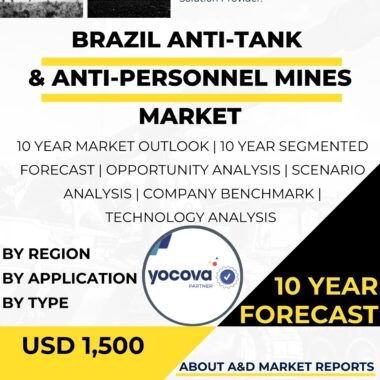Description
Germany Anti-Tank & Anti-Personnel Mines Market
Germany anti-tank & anti-personnel mines market has been a significant and sensitive segment within the country’s defense industry. Anti-tank and anti-personnel mines are explosive devices designed to target enemy vehicles and personnel, respectively. While anti-tank mines are intended to immobilize or destroy armored vehicles, anti-personnel mines are meant to inflict casualties and hinder enemy movements. The use and trade of these mines are regulated under international treaties due to the potential humanitarian and environmental impact. In recent years, Germany has been focused on addressing the legacy of landmines and promoting mine clearance efforts, while also contributing to the development and deployment of modern, responsible, and treaty-compliant mine systems.
The Germany anti-tank and anti-personnel mines market is influenced by several factors, including the country’s commitment to humanitarian disarmament, its role as a signatory to international mine ban treaties, and its recognition of the importance of responsible and compliant mine warfare practices. Germany is a party to the Ottawa Treaty, also known as the Mine Ban Treaty, which prohibits the use, stockpiling, production, and transfer of anti-personnel mines.
The market encompasses both domestic production and exports of mine-related technologies, including mine detection, clearance equipment, and mine-resistant vehicles. Germany has reputable defense companies and manufacturers that develop and produce mine-related equipment, ensuring their compliance with international standards and regulations. Additionally, Germany collaborates with other countries and provides assistance in mine clearance efforts, contributing to humanitarian demining operations globally.
The Germany anti-tank and anti-personnel mines market is characterized by a focus on innovation and technological advancements. Companies in Germany continuously strive to develop and improve mine detection and clearance technologies to aid in the safe removal of landmines, reducing the risk of civilian casualties and facilitating post-conflict reconstruction. The integration of advanced sensors, robotics, and data analytics has been a key area of research and development to enhance the effectiveness and safety of mine clearance operations.
One of the challenges faced by the Germany anti-tank and anti-personnel mines market is the legacy of landmines in conflict-affected regions around the world. Germany is actively engaged in mine clearance efforts and supports the clearance of mined areas in collaboration with international organizations and partners. This reflects Germany’s commitment to addressing the humanitarian impact of landmines and promoting peacebuilding and post-conflict recovery.
The export potential of German mine-related technologies is another aspect of the market. While Germany is a signatory to the Ottawa Treaty, it may export mine clearance equipment and assistance for humanitarian purposes to support mine-affected countries in their clearance efforts. Export decisions are subject to strict compliance with international treaties and regulations, ensuring that the equipment is used for legitimate and humanitarian purposes only.
The Germany anti-tank and anti-personnel mines market also addresses concerns related to mine awareness and risk education. Ensuring that affected communities and humanitarian workers are educated about the dangers of landmines and how to identify and avoid them is crucial for preventing accidents and casualties. Germany actively supports mine risk education programs to enhance the safety of local populations in mine-affected regions.
In recent years, there has been a growing emphasis on the development of mine clearance technologies and approaches that align with environmental sustainability. Germany is investing in research and development to explore how innovative mine detection and clearance methods can minimize environmental impact and preserve biodiversity in mined areas.
Moreover, the market is witnessing increased attention to promoting responsible mine warfare practices and advocating for the universalization of international mine ban treaties. Germany actively engages in diplomatic efforts to encourage other countries to join the Ottawa Treaty and commit to the elimination of anti-personnel mines.
In conclusion, the Germany anti-tank and anti-personnel mines market is a significant and sensitive segment within the country’s defense industry. While Germany is a signatory to international mine ban treaties, it actively engages in mine clearance efforts and supports humanitarian demining operations. The market is driven by Germany’s commitment to humanitarian disarmament, advancements in mine clearance technologies, and the need to address the legacy of landmines in conflict-affected regions. As Germany continues to invest in research, development, and mine clearance initiatives, the anti-tank and anti-personnel mines market is expected to play an increasingly pivotal role in shaping the country’s humanitarian and peacebuilding efforts worldwide.




